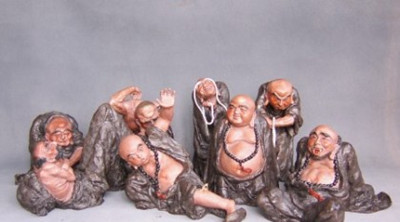Ceramic figures like these were made in huge numbers for about 50 years, around 700. Their sole purpose was to be placed in high-status tombs. They have been found all around the great Tang cities of north-west China, where Liu Tingxun held office. The ancient Chinese believed you needed to have in the grave all the things which were essential to you in life. So the figures were just one element in the total contents of Liu Tingxun's tomb, which would also have contained sumptuous burial objects of silk and lacquer, silver and gold. While the animal and human statues would serve and entertain him, the supernatural guardian figures warded off malevolent spirits. You could hardly make better preparation for being dead!
公元700年左右,類似的陶俑在五十年間被大量制造,而其唯一用途便是立于位高權(quán)重者的墳?zāi)怪小T趧⑼④魅温毜闹袊鞅辈浚笮统鞘写罅砍鐾亮诉@種陶俑。古代中國人認(rèn)為,人應(yīng)該用一切在世時(shí)的必需品作陪葬,因而陶俑只是劉廷茍墓葬的一部分,此外還有可觀的絲綢、漆器、白銀、黃金等奢侈物品。人俑與獸俑能夠服侍和取悅墓主,神獸俑則用于驅(qū)邪鎮(zhèn)魔。
Between their manufacture and their entombment, the ceramic figures would have been displayed to the living only once, when they were carried in the funeral cortege. They were never intended to be seen again. Once in the tomb, they took up their unchanging positions around the coffin, and then the stone door was firmly closed for eternity. A Tang poet of the time, Zhang Yue, commented:
從制造完工到人葬,這些陶俑應(yīng)該只有一次在世人面前露面的機(jī)會(huì),即在出殯時(shí)被運(yùn)往墓地的過程中,此后便該永不再見天日。進(jìn)入墓室之后,它們便按照一定位置圍繞若棺木擺放,其后石門會(huì)被永久閉合。其時(shí)有位詩人張說評(píng)價(jià)道:
"All who come and go follow this road,
往來皆此路,
But living and dead do not return together."
生死不間歸。
Like so much else in eighth-century China, the production of ceramic figures like these ones was controlled by an official bureau, just one small part of the enormous civil service that powered the Tang state.
與8世紀(jì)中國的各種物品一樣,陶俑制造業(yè)受某個(gè)官方部門的控制,而該部門只是維系唐朝社會(huì)運(yùn)行的龐大官吏系統(tǒng)中的一小部分。












